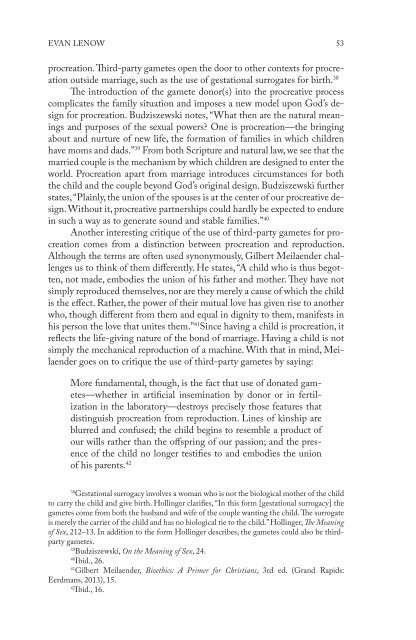experienced praying donating
SWJT%2059.1_Lenow
SWJT%2059.1_Lenow
You also want an ePaper? Increase the reach of your titles
YUMPU automatically turns print PDFs into web optimized ePapers that Google loves.
EVAN LENOW 53<br />
procreation. Third-party gametes open the door to other contexts for procreation<br />
outside marriage, such as the use of gestational surrogates for birth. 38<br />
The introduction of the gamete donor(s) into the procreative process<br />
complicates the family situation and imposes a new model upon God’s design<br />
for procreation. Budziszewski notes, “What then are the natural meanings<br />
and purposes of the sexual powers? One is procreation—the bringing<br />
about and nurture of new life, the formation of families in which children<br />
have moms and dads.” 39 From both Scripture and natural law, we see that the<br />
married couple is the mechanism by which children are designed to enter the<br />
world. Procreation apart from marriage introduces circumstances for both<br />
the child and the couple beyond God’s original design. Budziszewski further<br />
states, “Plainly, the union of the spouses is at the center of our procreative design.<br />
Without it, procreative partnerships could hardly be expected to endure<br />
in such a way as to generate sound and stable families.” 40<br />
Another interesting critique of the use of third-party gametes for procreation<br />
comes from a distinction between procreation and reproduction.<br />
Although the terms are often used synonymously, Gilbert Meilaender challenges<br />
us to think of them differently. He states, “A child who is thus begotten,<br />
not made, embodies the union of his father and mother. They have not<br />
simply reproduced themselves, nor are they merely a cause of which the child<br />
is the effect. Rather, the power of their mutual love has given rise to another<br />
who, though different from them and equal in dignity to them, manifests in<br />
his person the love that unites them.” 41 Since having a child is procreation, it<br />
reflects the life-giving nature of the bond of marriage. Having a child is not<br />
simply the mechanical reproduction of a machine. With that in mind, Meilaender<br />
goes on to critique the use of third-party gametes by saying:<br />
More fundamental, though, is the fact that use of donated gametes—whether<br />
in artificial insemination by donor or in fertilization<br />
in the laboratory—destroys precisely those features that<br />
distinguish procreation from reproduction. Lines of kinship are<br />
blurred and confused; the child begins to resemble a product of<br />
our wills rather than the offspring of our passion; and the presence<br />
of the child no longer testifies to and embodies the union<br />
of his parents. 42<br />
38<br />
Gestational surrogacy involves a woman who is not the biological mother of the child<br />
to carry the child and give birth. Hollinger clarifies, “In this form [gestational surrogacy] the<br />
gametes come from both the husband and wife of the couple wanting the child. The surrogate<br />
is merely the carrier of the child and has no biological tie to the child.” Hollinger, The Meaning<br />
of Sex, 212–13. In addition to the form Hollinger describes, the gametes could also be thirdparty<br />
gametes.<br />
39<br />
Budziszewski, On the Meaning of Sex, 24.<br />
40<br />
Ibid., 26.<br />
41<br />
Gilbert Meilaender, Bioethics: A Primer for Christians, 3rd ed. (Grand Rapids:<br />
Eerdmans, 2013), 15.<br />
42<br />
Ibid., 16.


